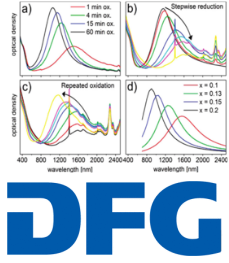-
Colloid chemically produced strongly doped (degenerate) semiconducting and oxidic nanocrystals with localized surface plasmon resonances (DFG research project)The occurrence of localized surface plasmon resonances (LSPRs) is now a well-known and well-researched phenomenon in noble metal nanoparticles. Due to this fascinating physical effect, there is a variety of research and application areas such as nanooptics, fluorescence amplification, surface enhanced Raman spectroscopy (SERS), plasmon-based sensor technology and much more. However, so far there are hardly any alternatives to the noble metal materials in the field of nanoparticles containing LSPR, which limits the applicability to special areas of the spectrum and is associated with high material costs. To address this deficiency, the project aims at the synthesis and characterization of a new class of plasmon nanocrystals, i.e. highly doped metal oxide and semiconductor nanoparticles with plasmonic properties. For this purpose, synthesis strategies for strongly self-doped semiconductor nanomaterials such as Cu(2-x)Se are developed, as well as synthesis strategies for strongly doped nanocrystals of zinc oxide and tin oxide. Furthermore, for these new materials it is expected that the control of the chemical and dielectric environment of the nanoparticles is critical to change or stabilize the plasmonic properties of the nanocrystals. Therefore, a fine tuning of LSPR frequencies will be performed by the development and application of post-synthetic processing steps such as shell growth or ligand exchange, and finally, this new type of plasmonic nanoparticles will be investigated with respect to the possibility of replacing or complementing the current gold nanoparticles (or other precious metal nanoparticles) in LSPR-based sensory applications. A positive result would lead to an alternative (or complementary) class of plasmon nanoparticles and thus to a new nanoparticle family for applications in plasmon-based sensor systems.Led by: PD Dr. Dirk Dorfs, Prof. Dr. Wolfgang ParakTeam:Year: 2013Funding: DFG Deutsche Forschungsgemeinschaft
![]()
![]()
-
Hollow and Concave Colloidal Plasmonic Nanoparticles as Size and Shape Selective Sensors on the NanometerscaleIn the framework of this project, colloid chemically synthesized plasmonic nanoparticles shall be investigated with respect to their potential as size and shape selective sensors on the nanometerscale in liquid phase. For this purpose a variety of different plasmonic nanoparticles will be synthesized. Already this pure synthesis part of the project will go beyond the state of the art in nanoparticle synthesis. Apart from “normal” plasmonic particles from noble metals also plasmonic particles from highly doped (degenerately doped) semiconductor or oxide materials with localized surface plasmon resonances tunable in the near infrared part of the spectrum shall be synthesized and shall be compared with the classic metallic nanoparticles with respect to their sensory properties. The plasmonic particles can detect an analyte either via changes of the dielectric constant of the surrounding or via other, specific interactions with the analyte. With respect to the latter point, especially plasmonic particles with concave or cylindrical voids at the particle surface shall be synthesized, which can show size and shape selective interactions with different analytes (see also scheme for e.g. key lock like interactions) which finally can easily be detected by a change of the resonance frequency of the localized surface plasmon resonance of these particles.Led by: PD Dr. Dirk Dorfs, Prof Dr. Detlef BahnemannTeam:Year: 2016Funding: Hannover School of Nanotechnology
-
Plasmonic nanocrystals and multicomponent nanocrystals for activation of chemical reactions by ultrashort temperature pulsesThis project aims to investigate the effects of ultrafast heated plasmonic nanoparticles in colloidal solution on their environment and in particular on chemical reactions occurring in their environment. Plasmonic nanoparticles can be heated extremely quick and strongly by ultrashort (nanoseconds or picoseconds) laser pulses. Plasmonic nanoparticles have some unique properties: Their extinction coefficients are extremely high and even with the most intense laser irradiation there is hardly any fading effect during the laser pulse compared to other materials. In addition, the spectral position of the plasmon resonance can be adjusted practically arbitrarily by material selection as well as size and shape of the particles. As a consequence, such plasmon nanoparticles can even be heated by single picosecond laser pulses by more than 1000°C; initially without their environment being heated. In this project, the effects of such extremely short and extremely localized temperature peaks on the chemical reactions of reactants, which are also present in the colloidal solutions of such nanoparticles, will be investigated. suitable plasmonic nanoparticles will first be produced, whereby degenerate doped semiconductor particles with plasmon resonances in the near infrared spectral range will be produced in addition to classical noble metal nanoparticles. Multicomponent particles are also produced, which consist of a plasmonic part for rapid heating under laser irradiation and another part of a catalytically active material. The heat generated by the laser pulse in the plasmonic particle is transferred to the catalytically active part and a chemical reaction takes place on its surface. Various simple chemical reactions, which either take place directly on the surface of the rapidly heatable nanoparticles or in their immediate environment in solution, are investigated. The conditions are chosen so that macroscopically there is practically no heating of the solution and only extremely short and extremely localized temperature peaks occur. The results of these investigations will allow conclusions to be drawn about how heat conduction in solutions takes place on extremely short time scales and over very short distances, whereby such scenarios are also of particular interest in which the particle temperature directly after the temperature pulse is significantly above the boiling temperature of the solvent, since such scenarios cannot be realized on a macroscopic scale.Led by: PD Dr. Dirk Dorfs, Prof. Dr. Carsten ReinhardTeam:Year: 2017Funding: DFG Deutsche ForschungsgemeinschaftDuration: 3 years
![]()
![]()





